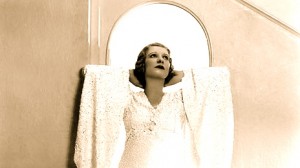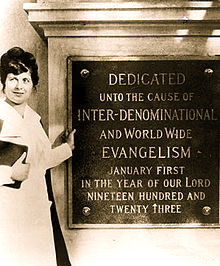Aimee Semple McPherson
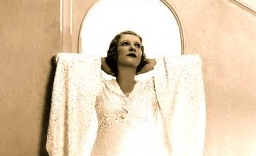
Aimee Semple McPherson
A documentary on the life of Aimee Semple McPherson chronicling her early life, failed marriages, tremendous ministry and popularity, alleged kidnapping and more.
(born October 9, 1890 – died September 27, 1944), also known as Sister Aimee, was a Canadian-American Los Angeles–based evangelist and media celebrity in the 1920s and 1930’s. She founded the Foursquare Church. McPherson has been noted as a pioneer in the use of modern media, especially radio, and was the second woman to be granted a broadcast license. She used radio to draw on the growing appeal of popular entertainment in North America and incorporated other forms into her weekly sermons at Angelus Temple.
In her time she was the most publicized Christian evangelist, surpassing Billy Sunday and her other predecessors. She conducted public faith-healing demonstrations before large crowds; testimonies conveyed tens of thousands of people healed. McPherson’s articulation of the United States as a nation founded and sustained by divine inspiration continues to be echoed by many pastors in churches today. News coverage sensationalized misfortunes with family and church members; particularly inflaming accusations she had fabricated her reported kidnapping, turning it into a national spectacle. McPherson’s preaching style, extensive charity work and ecumenical contributions were a major influence in revitalization of American Evangelical Christianity in the 20th century.
Biography – Early Life
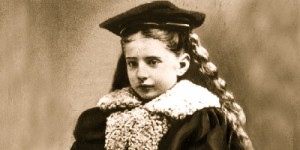 McPherson was born Aimee Elizabeth Kennedy on a farm in Salford, Ontario, Canada. Her father, James Kennedy, was a farmer. Young Aimee got her early exposure to religion through her mother, Mildred – known as Minnie. McPherson’s later work in spreading the Gospel was a result of watching her mother work with the poor in Salvation Army soup kitchens.
McPherson was born Aimee Elizabeth Kennedy on a farm in Salford, Ontario, Canada. Her father, James Kennedy, was a farmer. Young Aimee got her early exposure to religion through her mother, Mildred – known as Minnie. McPherson’s later work in spreading the Gospel was a result of watching her mother work with the poor in Salvation Army soup kitchens.
As a child she would play “Salvation Army” with her classmates, and at home she would gather a congregation with her dolls, giving them a sermon. As a teenager, McPherson strayed from her mother’s teachings by reading novels and going to movies and dances, activities which were strongly disapproved of by both the Salvation Army and the faith of her father, a Methodist. Novels, though, made their way into the Methodist Church library and with guilty delight, McPherson would read them. At the movies, she recognized some of her fellow Methodist church members. She learned too, at a local dance she attended, that her dancing partner was a Presbyterian minister. In high school, she was taught Charles Darwin’s Theory of Evolution. She began to quiz visiting preachers and local pastors about faith and science, but was unhappy with the answers she received. She stunned her father, who almost fell backwards while carrying a pan of milk up the basement stairs by asking him, “How do you know there is a God?” She wrote to the Canadian newspaper, Family Herald and Weekly Star, questioning why taxpayer-funded public schools had courses, such as evolution, which undermined Christianity. While still in high school, after her Pentecostal conversion, McPherson began a crusade against the concept of evolution, beginning a lifelong passion.
Marriage and Family
 Robert and Aimee Semple (1910)
Robert and Aimee Semple (1910)
While attending a revival meeting in December 1907, Aimee met Robert James Semple, a Pentecostal missionary from Ireland. After a short courtship, they were married on August 12, 1908 in a Salvation Army ceremony, pledging never to allow their marriage to lessen their devotion to God, affection for comrades or faithfulness in the Army. The pair’s notion of “Army” was very broad, encompassing much more than just the Salvation Army. Robert supported them as a foundry worker and preached at the local Pentecostal mission. Together, they studied the Bible, Aimee claiming Robert taught her all she knew; though other observers state she was far more knowledgeable than she let on. After a few months they moved to Chicago and became part of William Durham’s Full Gospel Assembly. Under Durham’s tutelage, Aimee was discovered to have a unique ability in the interpretation of speaking in tongues, translating with stylistic eloquence the otherwise indecipherable utterances of persons who began to speak in a language unknown to them.
The two then embarked on an evangelical tour, first to Europe and then to China, where they arrived in June 1910, with Aimee about six months pregnant. Shortly after disembarking in Hong Kong, both contracted malaria and Robert, dysentery. Robert Semple died of the illnesses on August 19, 1910, and was buried in Hong Kong Cemetery. Aimee Semple recovered and gave birth to their daughter, Roberta Star Semple, on September 17, 1910. Alone, with just the wailing of her newborn daughter, Aimee Semple was now a 19-year-old widow. Her mother, Mildred Kennedy wired her funds for the return journey to the United States. On-board ship, Aimee Semple started a Sunday school class then held other services as well. Almost all the passengers attended. On her departure, a collection was taken by the ship’s purser and the amount given was just enough to pay for travel to her hometown. Robert Semple never left her thoughts; she displayed his photo in her parlor and spoke of him glowingly, even dreamily, in her sermons, as a lifelong inspiration.
 Shortly after her recuperation in the United States, Semple joined her mother Minnie working with the Salvation Army. While in New York City, she met Harold Stewart McPherson, an accountant. They were married on May 5, 1912, moved to Rhode Island and had a son, Rolf Potter Kennedy McPherson in March 1913.
Shortly after her recuperation in the United States, Semple joined her mother Minnie working with the Salvation Army. While in New York City, she met Harold Stewart McPherson, an accountant. They were married on May 5, 1912, moved to Rhode Island and had a son, Rolf Potter Kennedy McPherson in March 1913.
McPherson tried to live the life of the dutiful housewife, had a devoted husband and a fine home, but was instead miserable as she denied her “calling” to go preach. She became emotionally erratic, sulking in a corner, lethargic, then tempestuous with a raging temper. Next she would tackle household chores with prolonged obsessional detail and afterwards fall to weeping and praying. After the birth of her second child, Rolf, she felt the call to preach tug at her even more strongly. In response, she helped with worship services in several Pentecostal churches in and around the Providence, Rhode Island area. But, this did not satisfy the voice which told her, as McPherson claimed, to go and do the work of an evangelist.
Then in 1914, she fell seriously ill, and after a failed operation she was left in the holding room where patients were taken to die. In her delirium, McPherson states she again heard the persistent voice, asking her to go preach. Feeling that either her life was at an end or she would go preach, McPherson accepted the voice’s challenge. The astounded nurse looked on as McPherson suddenly opened her eyes and was able to turn over in bed without pain. One spring morning in 1915, her husband returned home from the night shift to discover McPherson had left him and taken the children. A few weeks later, a note was received inviting him to join her in evangelistic work.
McPherson of this period wrote:
“Oh, don’t you ever tell me that a woman can not be called to preach the Gospel! If any man ever went through one hundredth part of the hell on earth that I lived in, those months when out of God’s will and work, they would never say that again.”
McPherson intended the Angelus Temple as both a place of worship and an ecumenical center for persons of all Christian faiths to meet and build alliances. A wide range of clergy and laypeople to include Methodists, Baptists, the Salvation Army, Presbyterians, Episcopalians, Adventists, Quakers, Roman Catholics, Mormons and secular civic leaders came to the Angelus Temple. They were welcomed and many made their way to her podium as guest speakers. Eventually, even Rev. Robert P. Shuler, a once robust McPherson critic, was featured as a guest preacher.
In August 1925 and away from Los Angeles, McPherson decided to charter a plane so she would not miss giving her Sunday sermon. Aware of the opportunity for publicity, she arranged for at least two thousand followers and members of the press to be present at the airport. The plane failed after takeoff and the landing gear collapsed, sending the nose of the plane into the ground. McPherson boarded another plane and used the experience as the narrative of an illustrated Sunday sermon called “The Heavenly Airplane.” The stage in Angelus Temple was set up with two miniature planes and a skyline that looked like Los Angeles. In this sermon, McPherson described how the first plane had the devil for the pilot, sin for the engine, and temptation as the propeller. The other plane, however, was piloted by Jesus and would lead one to the Holy City (the skyline shown on stage). The temple was filled beyond capacity.
On another occasion, she described being pulled over by a police officer, calling the sermon “Arrested for Speeding”. Dressed in a traffic cop’s uniform, she sat in the saddle of a police motorcycle, earlier placed on the stage, and revved the siren. One author in attendance, insisted she actually drove the motorcycle, with its deafening roar, across the access ramp to the pulpit, slammed on the brakes, then raised a white gloved hand to shout “Stop! You’re speeding to Hell!” Since McPherson gave some of her sermons more than once, and with variations, the possibility existed both versions might be true.
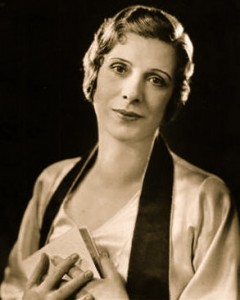 McPherson employed a small group of artists, electricians, decorators, and carpenters who built the sets for each Sunday’s service. Religious music was played by an orchestra. McPherson also worked on elaborate sacred operas. One production, The Iron Furnace, based on the book of Exodus, told of God’s deliverance as the Israelites fled slavery in Egypt. Some Hollywood movie stars even assisted with obtaining costumes from local studios. The cast was large, perhaps as many as 450 people but so elaborate and expensive, it was presented only one time. Rehearsals for the various productions were time consuming and McPherson “did not tolerate any nonsense.” Though described as “always kind and loving,” McPherson demanded respect regarding the divine message the sacred operas and her other works were designed to convey.
McPherson employed a small group of artists, electricians, decorators, and carpenters who built the sets for each Sunday’s service. Religious music was played by an orchestra. McPherson also worked on elaborate sacred operas. One production, The Iron Furnace, based on the book of Exodus, told of God’s deliverance as the Israelites fled slavery in Egypt. Some Hollywood movie stars even assisted with obtaining costumes from local studios. The cast was large, perhaps as many as 450 people but so elaborate and expensive, it was presented only one time. Rehearsals for the various productions were time consuming and McPherson “did not tolerate any nonsense.” Though described as “always kind and loving,” McPherson demanded respect regarding the divine message the sacred operas and her other works were designed to convey.
Even though McPherson condemned theater and film as the devil’s workshop, its secrets and effects were co-opted. She became the first woman evangelist to adopt the whole technique of the moving picture star. McPherson desired to avoid the dreary church service where by obligation parishioners would go to fulfill some duty by being present in the pew. She wanted a sacred drama that would compete with the excitement of vaudeville and the movies. The message was serious, but the tone more along the lines of a humorous musical comedy. Missed cues, forgotten or misstated script lines and other mistakes became part of the gag. Animals were frequently incorporated and McPherson, the once farm girl, knew how to handle them. In one incident, a camel was to squeeze through a narrow gate set up on stage, illustrating the Eye of the Needle. McPherson unlimbered one bag of cargo after another labeled “Worldly Pleasure,” “Indifference to the Poor” and others, from the camel. Until all the cargo burdens were removed, the camel could not cross through the opening. McPherson gave up to 22 sermons a week and the lavish Sunday night service attracted the largest crowds, extra trolleys and police were needed to help route the traffic through Echo Park to and from Angelus Temple. To finance the Angelus Temple and its projects, collections were taken at every meeting, often with the admonishment, “no coins, please.”
Because Pentecostalism was not popular in the U.S. during the 1920’s, McPherson avoided the label. She did, though, demonstrate speaking-in-tongues and faith healing in sermons. She also kept a museum of discarded medical fittings from persons faith healed during her services which included crutches, wheelchairs, and other paraphernalia. As evidence of her early influence by the Salvation Army, McPherson adopted a theme of “lighthouses” for the satellite churches, referring to the parent church as the “Salvation Navy.” This was the beginning of McPherson working to plant Foursquare Gospel churches around the country.
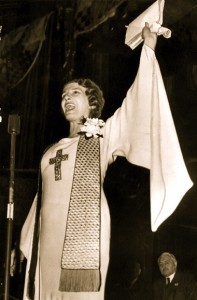 McPherson published the weekly Foursquare Crusader, along with her monthly magazine, Bridal Call. She began broadcasting on radio in the early 1920’s. McPherson was one of the first women to preach a radio sermon. With the opening of Foursquare Gospel-owned KFSG on February 6, 1924, she became the second woman granted a broadcast license by the Department of Commerce, the federal agency that supervised broadcasting in the early 1920’s.
McPherson published the weekly Foursquare Crusader, along with her monthly magazine, Bridal Call. She began broadcasting on radio in the early 1920’s. McPherson was one of the first women to preach a radio sermon. With the opening of Foursquare Gospel-owned KFSG on February 6, 1924, she became the second woman granted a broadcast license by the Department of Commerce, the federal agency that supervised broadcasting in the early 1920’s.
McPherson racially integrated her tent meetings and church services. On one occasion, as a response to McPherson’s ministry and Angelus Temple being integrated, Ku Klux Klan members were in attendance, but after the service hoods and robes were found on the ground in nearby Echo Park. She is also credited with helping many Hispanic ministries in Los Angeles.
McPherson traveling about the country holding widely popular revival meetings and filling local churches with converts was one thing, settling permanently into their city caused concern among some local Los Angeles churches. Even though she shared many of their fundamentalist beliefs: divine inspiration of the Bible, the classical Trinity, virgin birth of Jesus, historical reality of Christ’s miracles, bodily resurrection of Christ and the atoning purpose of his crucifixion; the presentation of lavish sermons, and an effective faith healing ministry presented by a female divorcee who thousands adored and newspapers continuously wrote of, was unexpected. Moreover, the Temple, especially the women, had a look and style uniquely theirs. They would emulate McPherson’s style and dress, and a distinct Angeleus Temple uniform came into existence, a white dress with a navy blue cape thrown over it. Men were more discrete, wearing suits. Her voice, projected over the powerful state-of-the-art KFSG radio station and heard by hundreds of thousands, became the most recognized in the western United States.
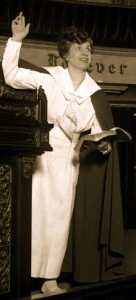 McPherson preaching at the newly built Angelus Temple in 1923. Her messages showcased the love of God, redemption and the joys of service and heaven; contrasting sharply with the fire and brimstone style of sermon delivery popular with many of her peers.
McPherson preaching at the newly built Angelus Temple in 1923. Her messages showcased the love of God, redemption and the joys of service and heaven; contrasting sharply with the fire and brimstone style of sermon delivery popular with many of her peers.
Her illustrated sermons attracted criticism from some clergy members because they thought it turned the gospel message into mundane theater and entertainment. Divine healing, as McPherson called it, was claimed by many pastors to be a unique dispensation granted only for Apostolic times. Reverend Robert P. Shuler published a pamphlet entitled McPhersonism, which purported that her “most spectacular and advertised program was out of harmony with God’s word.” Debates such as the Bogard-McPherson Debate in 1934 drew further attention to the controversy, but none could really argue effectively against McPherson’s results.
The new developing Assemblies of God denomination, Pentecostal as McPherson was, for a time worked with her, but they encouraged separation from established Protestant faiths. McPherson resisted trends to isolate as a denomination and continued her task of coalition building among evangelicals. McPherson worked hard to attain ecumenical vision of the faith and while she participated in debates, avoided pitched rhetorical battles that divided so many in Christianity. She wanted to work with existing churches on projects and to share with them her visions and beliefs. Assisting in her passion was the speedy establishment of LIFE Bible College adjacent to the Angeles Temple. Ministers trained there were originally intended to go nationally and worldwide to all denominations and share her newly defined “Foursquare Gospel.” A well known Methodist minister, Frank Thompson, who never had the Pentecostal experience, was persuaded to run the college; and he taught the students the doctrine of John Wesley. McPherson and others, meanwhile, infused them with Pentecostal ideals. Her efforts eventually led Pentecostals, which were previously unconventional and on the periphery of Christianity, into the mainstream of American evangelicalism.
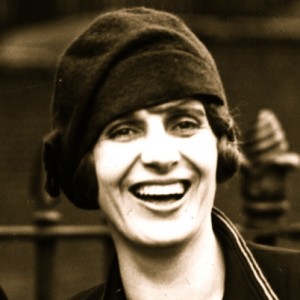 McPherson herself steadfastly declined to publicly criticize by name any individual with rare exceptions, but those who were converted in her services were not so careful. The testimonies of former prostitutes, drug addicts and others, from stage or broadcast over the radio, frequently revealed the names and locations concerning their past illegal activities. These revelations angered many and McPherson often received hostile letters and death threats. An alleged plot to kidnap her and detailed in the Los Angeles Times was foiled in September, 1925.
McPherson herself steadfastly declined to publicly criticize by name any individual with rare exceptions, but those who were converted in her services were not so careful. The testimonies of former prostitutes, drug addicts and others, from stage or broadcast over the radio, frequently revealed the names and locations concerning their past illegal activities. These revelations angered many and McPherson often received hostile letters and death threats. An alleged plot to kidnap her and detailed in the Los Angeles Times was foiled in September, 1925.

